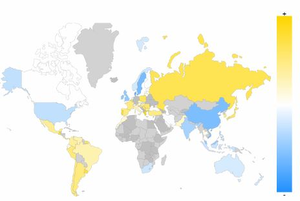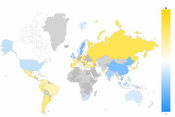Information
- Publication Type: Bachelor Thesis
- Workgroup(s)/Project(s):
- Date: August 2019
- Date (Start): 10. April 2019
- Date (End): 13. August 2019
- Matrikelnummer: 01614855
- First Supervisor: Renata Raidou
Abstract
Culture is a fascinating phenomenon influencing various aspects of our lives. Cultural models seek to describe the complex structure of ethical and societal values. Two main cultural models have been defined so far: the Hofstede model [Hof11] and the GLOBE project [GLO04]. Both models define similar attributes to describe characteristics of a society, summarized in so-called cultural dimensions. To better understand the complexity of cultural models and the information given there are tools that visualize the complex data provided. Current tools for the visualization of cultural models make use of barcharts, boxplots and scatterplots, while only covering a small part of the data and information given. The existing tools do not cover the information completely and miss vital aspects. We want to fill these gaps and seek to find a way to easily compare selected data with each other. Moreover, we want to design a visualization that can identify cultures and cultural regions. We try to create a tool to visualize cultural models. The tool displays the given data in an easy way, by using new approaches and improving existing ones. First, we analyze the data given, to crystallize the core information and main feature of our visualization. Next, the goal is to define the advantages and disadvantages of the current and latest visualization approaches. By combining the strengths and improving the weaknesses of these existing tools we try to specify the difficulties and goals we want to achieve with the new approach. Lastly, we look at ongoing cultural applications by using the developed visualization tool and look for similarities where we do not expect them.Additional Files and Images
Weblinks
No further information available.BibTeX
@bachelorsthesis{Bayat_2019,
title = "The Visualization of the Evolution of Cultural Models",
author = "Hannah Bayat",
year = "2019",
abstract = "Culture is a fascinating phenomenon influencing various
aspects of our lives. Cultural models seek to describe the
complex structure of ethical and societal values. Two main
cultural models have been defined so far: the Hofstede model
[Hof11] and the GLOBE project [GLO04]. Both models define
similar attributes to describe characteristics of a society,
summarized in so-called cultural dimensions. To better
understand the complexity of cultural models and the
information given there are tools that visualize the complex
data provided. Current tools for the visualization of
cultural models make use of barcharts, boxplots and
scatterplots, while only covering a small part of the data
and information given. The existing tools do not cover the
information completely and miss vital aspects. We want to
fill these gaps and seek to find a way to easily compare
selected data with each other. Moreover, we want to design a
visualization that can identify cultures and cultural
regions. We try to create a tool to visualize cultural
models. The tool displays the given data in an easy way, by
using new approaches and improving existing ones. First, we
analyze the data given, to crystallize the core information
and main feature of our visualization. Next, the goal is to
define the advantages and disadvantages of the current and
latest visualization approaches. By combining the strengths
and improving the weaknesses of these existing tools we try
to specify the difficulties and goals we want to achieve
with the new approach. Lastly, we look at ongoing cultural
applications by using the developed visualization tool and
look for similarities where we do not expect them.",
month = aug,
address = "Favoritenstrasse 9-11/E193-02, A-1040 Vienna, Austria",
school = "Research Unit of Computer Graphics, Institute of Visual
Computing and Human-Centered Technology, Faculty of
Informatics, TU Wien ",
URL = "https://www.cg.tuwien.ac.at/research/publications/2019/Bayat_2019/",
}

 Bachelor Thesis
Bachelor Thesis image
image

